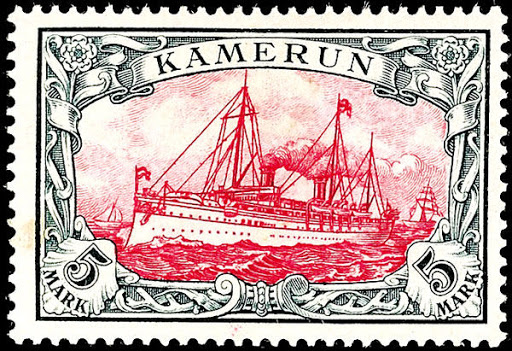Kamerun was an African colony of the German Colonial Empire from 1884 to 1916 in the region of today’s Republic of Cameroon. Kamerun also included northern parts of Gabon and the Congo with western parts of the Central African Republic, southwestern parts of Chad and far eastern parts of Nigeria.
The first German trading post in the Duala area on the Kamerun River delta was established in 1868 by the Hamburg trading company C. Woermann [de]. By 1884, Adolph Woermann, as spokesman for all West African companies, petitioned the imperial foreign office for “protection” by the German Empire. Imperial Chancellor Otto von Bismarck, sought to utilize the traders on site to govern the region via “chartered companies”.
Germany was particularly interested in Cameroon’s agricultural potential and asked large firms to exploit it and export its production. Large German trading companies (Woermann, Jantzen und Thoermalen) and concession companies (Sudkamerun Gesellschaft, Nord-West Kamerun Gesellschaft) established themselves massively in the colony. Letting the big companies impose their order, the administration simply supported them, protected them and eliminated native uprisings.
Germany planned to build a great African empire, which would connect Kamerun through the Congo to its East African possessions. The protectorate of Cameroon was established during the “Scramble for Africa”. Germany gradually expanded the colony, meeting with heavy resistance in the Bafut Wars and Adamawa Wars. With subsidies from the imperial treasury, the colony built two rail lines from the port city of Duala to bring agricultural products to market. The Cameroon protectorate was enlarged with New Cameroon (Neukamerun) in 1911 as part of the settlement of the Agadir Crisis, resolved by the Treaty of Fez.
At the outbreak of World War I, French, Belgian and British troops invaded the German colony in 1914 and fully occupied it during the Kamerun campaign. The last German fort to surrender was the one at Mora in the north of the colony in 1916.
Following Germany’s defeat, the Treaty of Versailles divided the territory into two League of Nations mandates (Class B) under the administration of Great Britain and France. French Cameroun and part of British Cameroons reunified in 1961 as Cameroon.
Articles
Blogs
- Germany & Colonies Philatelic Society – @GermanPhilately




